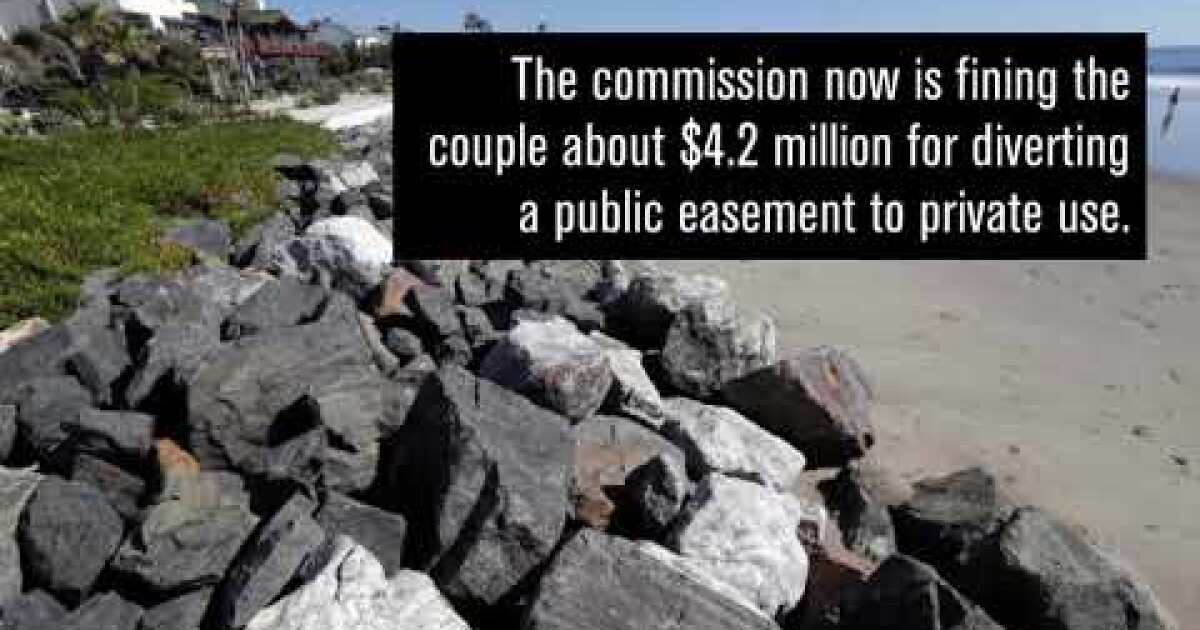odurandtina, the distinction between Massachusetts and California is that the citizens of Massachusetts have 'owned' parts of the tidelands of the Commonwealth since the early days of the Massachusetts Bay colony. There would be no Boston Harborwalk today if it were not for Chapter 91, as Chapter 91 was the means for securing public access on what otherwise was private property.
In California, the original owners of property owned the tidelands, and the state subsequently has sought to diminish that ownership by providing public access through the California Coastal Commission, which enforces the California Coastal Act of 1976. (California became a state in 1850, when numerous large ranches already exited, e.g., Warner's Ranch. In 1976, Jerry Brown was in hist term as governor, and Democrats controlled the legislature.)
The sweeping purpose and scope of the California Coastal Act of 1976 is outlined in the link below. A property owner could reasonably believe that this Act amounted to a confiscation.
With respect to the beach-coast at Malibu, where I recall you are known to frequent,
For decades, some Malibu property owners have made it hard for the public to reach public beaches.

www.latimes.com
For Hollister Ranch, see:
Also see an ongoing effort by the state of California to flex its power: Martin's Beach, and the billionaire owner of the beach.
After more than a decade of battles, the state is suing Vinod Khosla, arguing that the beach has been open to the public since the 1800s.

www.latimes.com
Stellar -- good summary of the "Current State" of "Beach Rights"
Actually in its infinite wisdom and desire to demonstrate such or at least keep the citizenry enthralled by such matters the Commonwealth has provided a web page devoted to the topic
Laws, regulations, cases, and web sources on beach rights law.

www.mass.gov
A couple of highlights of the history:
Massachusetts laws
Colonial ordinances of 1641-1647 Extended private ownership from the
mean high water line to the
mean low-water line, or 100 rods from the mean high-water line, whichever is less. Previously, ownership had extended only to the high-water mark (under
section 16 of the Body of Liberties of 1641).
MGL c.91 Waterways. Section 1 maintains the historical right of access to fish or fowl, defining "Private tidelands'', as "tidelands held by a private party subject to an easement of the public for the purposes of navigation and free fishing and fowling and of passing freely over and through the water."
MGL c.130 § 32 Fishing gear swept ashore; recovery. The owner of any fishing gear which is swept ashore by storm or tide or other natural causes and deposited upon the shore, beaches or flats, whether public or private, may recover the same within thirty days from the time of such deposit without liability for trespass.
The key all that follows are the terms which have never changed in over 350 years -- the Public has access to tidal lands for: fishing, fowling or general navigation through and above the waves -- and the words are very specific -- defining Private Tidelands as:
"tidelands held by a private party subject to an easement of the public for the purposes of navigation and free fishing and fowling and of passing freely over and through the water."
Thus on a nice summer day if you are above the Low Tide line -- even though you are walking in water up to your shoulders -- if you stroll beyond the boundaries of a Publicly owned beach -- you could be subject to arrest for trespassing. A few more inches deep so that you are floating or swimming and you are OK -- as by right you could be fowling?, fishing with your toes??, or navigating from one beach to another or just drifting with the winds.
Chapter 91 *1 passed by the Legislature and signed by the governor into law in 1866 uses these definitions in concert with a number of early Massachusetts Supreme Judicial Court rulings on specific challenges to expand on this Colonial Era concept. Later regulations built upon Chapt 91 have been challenged and these challenges have further defined the various possible relationships between Tidal Lands and the Citizenry.
So -- the answer with respect to all things
Tidal -- is -- Its
Complicated. But don't blame Boston or any city or town -- while this creature oozed off Beacon Hill nearly 400 years ago -- the Legislature and the Citizenry have not seen fit to revise the underlying principles to be compatible with the Information Age.
Refs from Official Commonwealth of MA sources:
Selected cases
Arno v. Commonwealth, 457 Mass. 434 (2010)
After registration, the landowner had fee simple title to any portion of his property that once was submerged tidelands, subject to a condition subsequent that his parcel be used for a public purpose, and fee simple title in any historical tidal flats, subject to an easement of the public.
Boston Waterfront Dev. Corp. v. Commonwealth, 378 Mass. 629 (1979)
Provides "a comprehensive overview of the history of Massachusetts tideland law."
Commonwealth v. Alger, 61 Mass. 53 (1851)
Called by the Supreme Judicial Court "probably the leading case on the subject."
Commonwealth v. City of Roxbury, 75 Mass. 451 (1857)
Explains at great length and in great detail the origins of and changes to property rights along the shore
.....
Navy Yard Four Associates v. Department of Environmental Protection, 88 Mass. App. Ct. 213 (2015)
Court upheld the validity of agency's definition of Commonwealth tidelands to include both submerged lands and tidal flats.
Opinion of the Justices to the House of Representatives, 365 Mass. 681 (1974)
In disapproving a proposed bill to allow walking along private beaches, court provides a clear summary of the law.
Spillane v. Adams, 76 Mass.App.Ct. 378 (2010)
Standard for low-water mark. "No definitive standard for tidal marks has been adopted in our appellate case law, and we take this opportunity to do so. The appropriate standard for low water mark is the 'mean low water' as determined by the NGVD."
Storer v. Freeman, 6 Mass. 435 (1810)
Explains the change in the law from low-water mark to high-water mark in 1641-47.
*1
another whole web site devoted to Tide Lands specifically chapt 91 [with a few excepts]

www.mass.gov
Overview: the purpose of Chapter 91
Adopted in 1866, Massachusetts General Law Chapter 91 protects the public's interest in waterways of the Commonwealth. It ensures that public rights to fish, fowl and navigate are not unreasonably restricted and that unsafe or hazardous structures are repaired or removed. Chapter 91 also protects the waterfront property owner's ability to approach his land from the water.
Why don't some people have permits or licenses?
Approximately 20,000 licenses have been issued since 1866, but many structures remain unlicensed for a variety of reasons. Many landowners don't realize they need authorization. Some owners simply are unaware of the law; others assume that prior owners obtained proper licensing; and still others don't know that a change in structure or use requires new licensing. Unlicensed structures are considered a public nuisance under M.G.L. Chapter 91, and their owners may be subject to MassDEP enforcement for maintaining unauthorized structures.
Are there penalties for unlicensed structures or work?
Unlicensed structures may be considered a public nuisance or a hazard to public safety or may significantly interfere with navigation. Unless properly licensed, these structures can be ordered removed and may be subject to fines. Our goal, however, is to bring people into compliance with Chapter 91, and the Department encourages owners of unlicensed structures to contact MassDEP and apply for a license to avoid enforcement action.
Can an owner maintain or repair licensed structures?
Maintenance or repair of licensed structures is not only allowed by Chapter 91, it is required. Required work must be performed according to the conditions of the license, including using materials of the same dimensions and quality and in the same locations and elevations as specified in the license. Common examples of replacement work include replacing old pilings, decking or rip-rap. Additionally, replacement or maintenance work can include: re-paving of road surfaces, installation of road curbs and lighting, stabilization of road or rail beds, reconstruction of culverts or catch basins, and maintenance or repair to public transportation facilities or drainage systems necessary to preserve the facilities for their original use.


